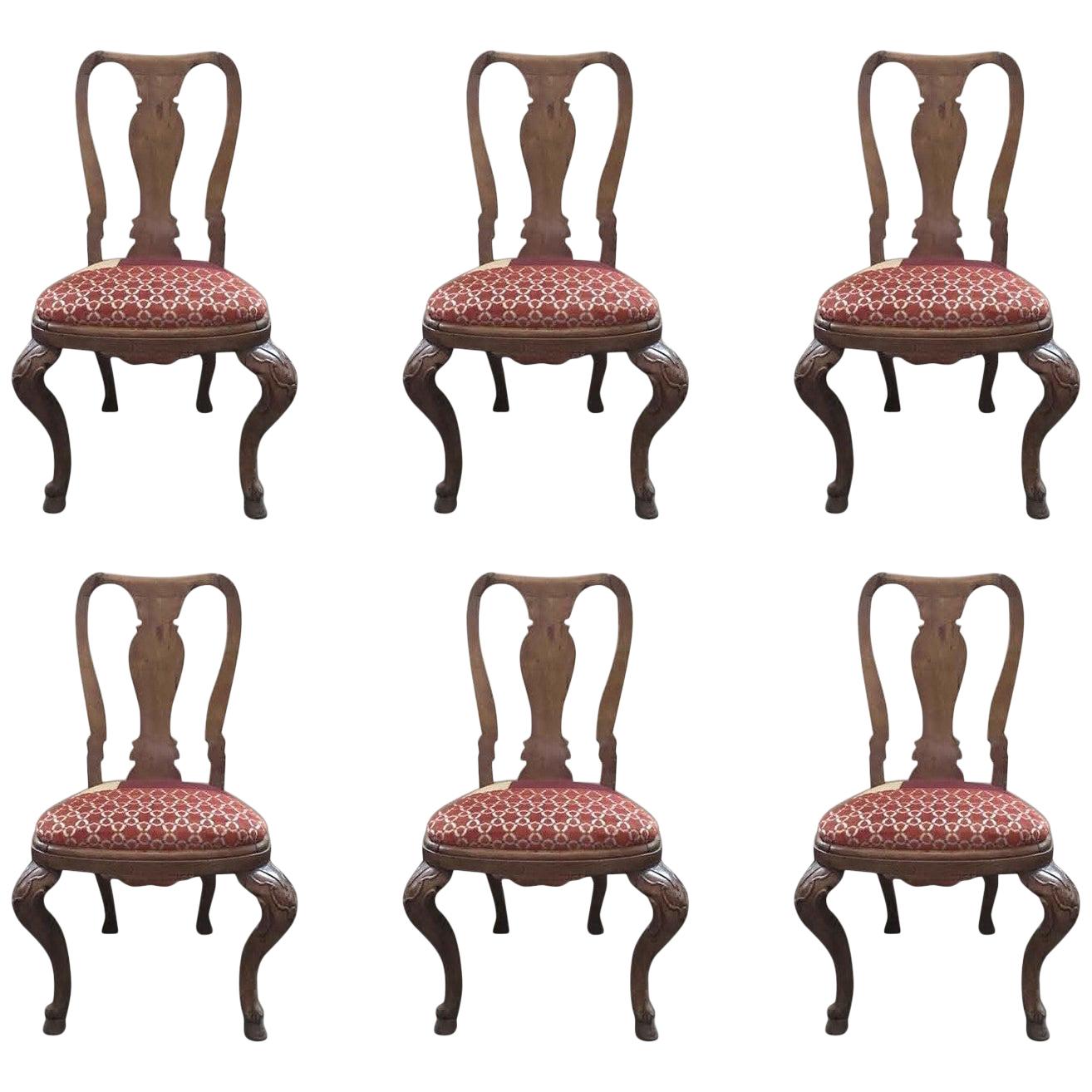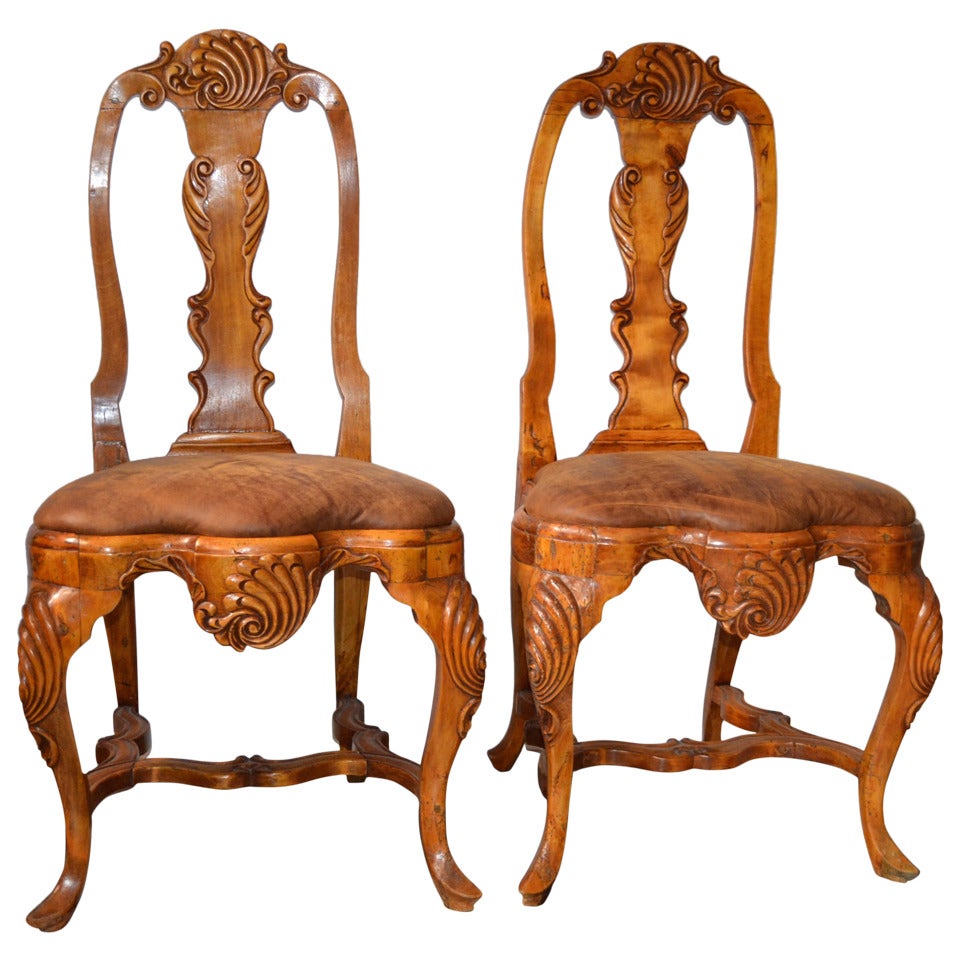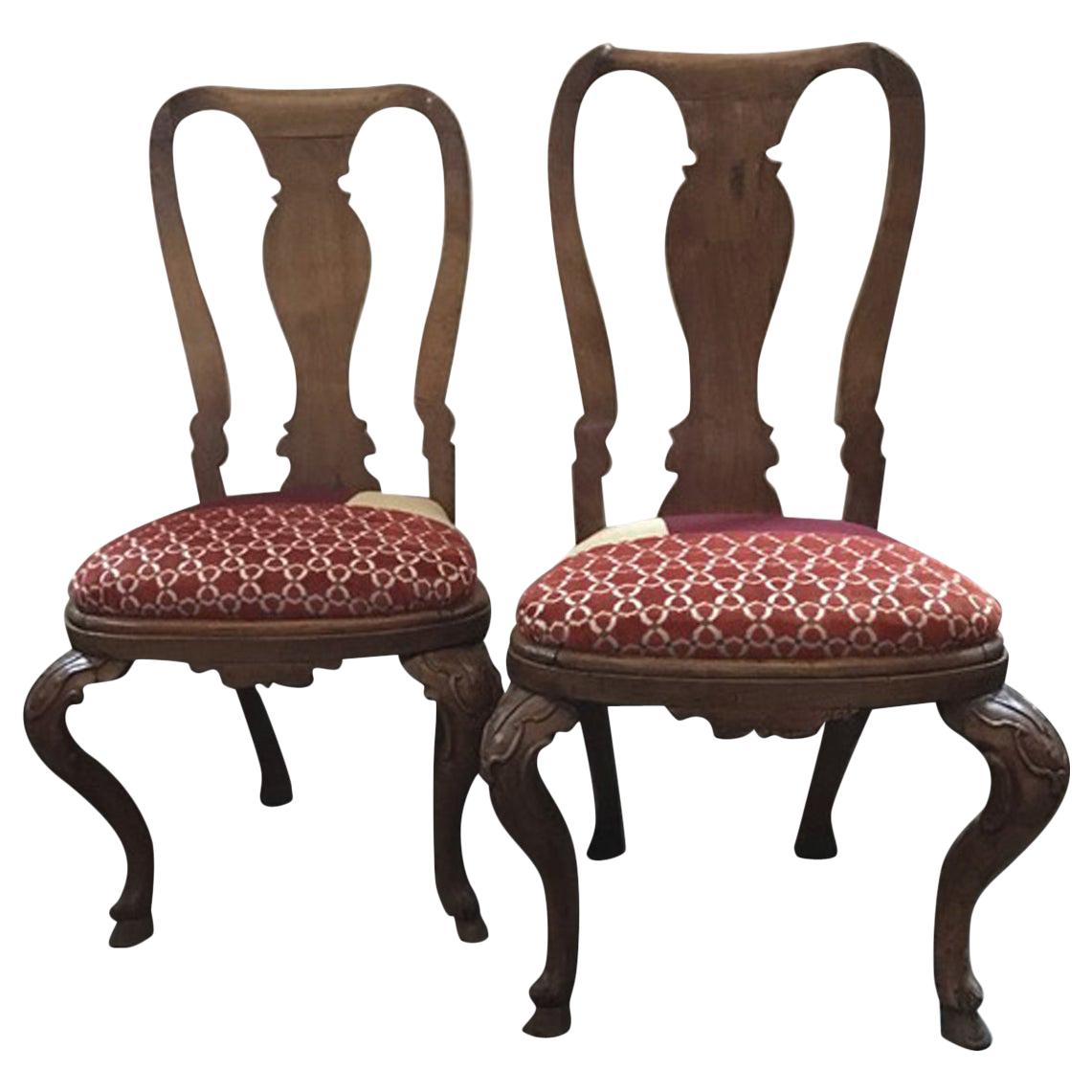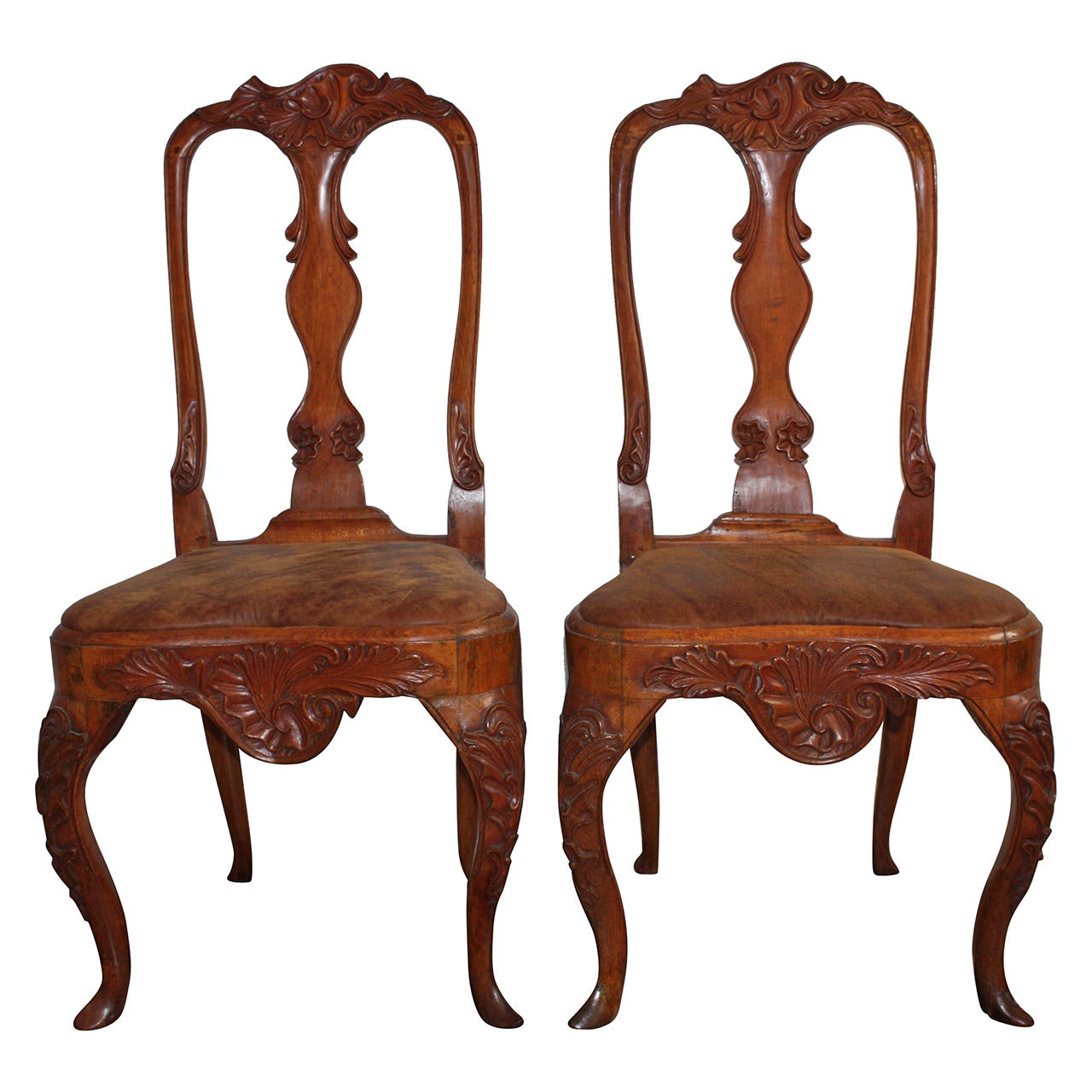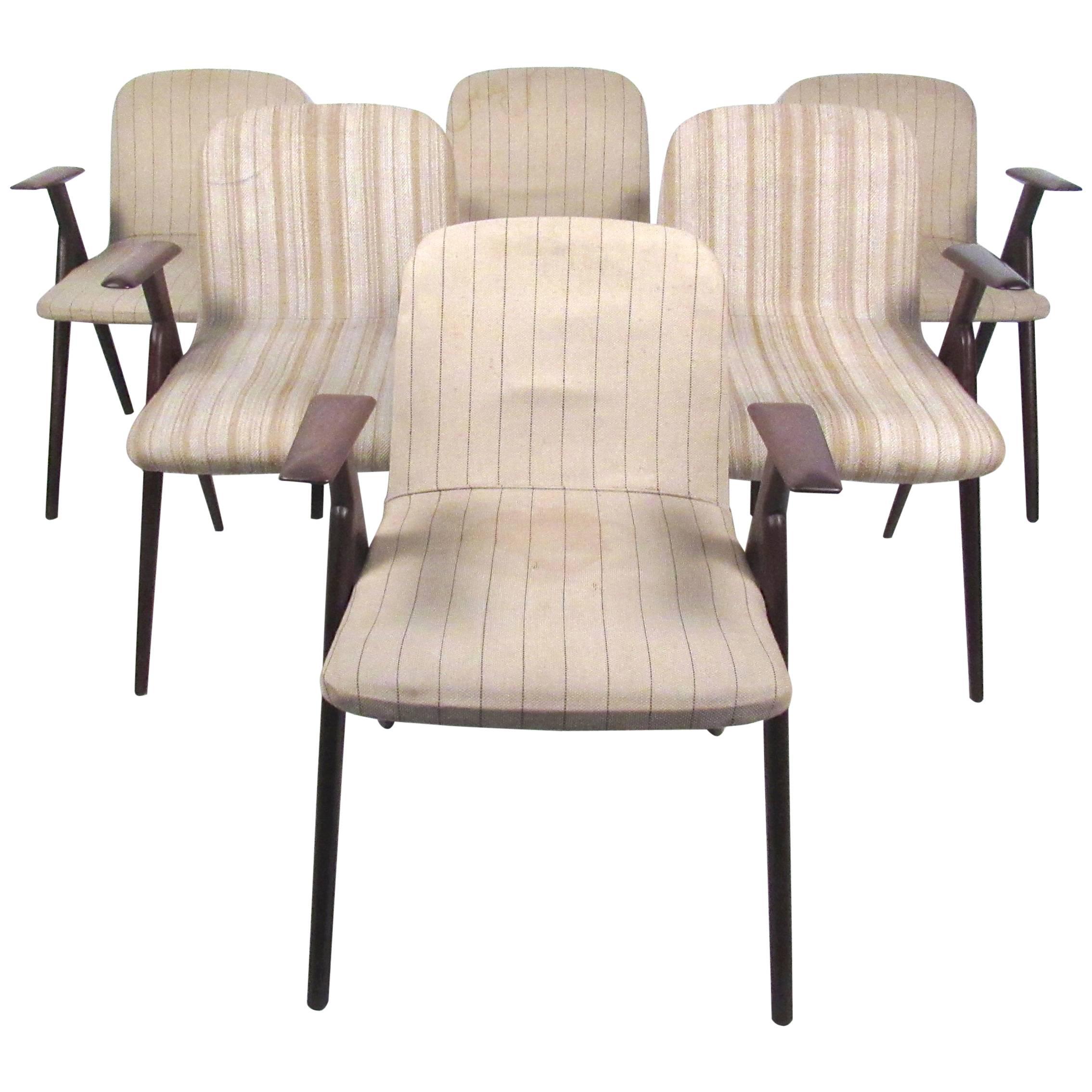Items Similar to Six Mid-18th Century Italian Chairs, Venice, circa 1750
Want more images or videos?
Request additional images or videos from the seller
1 of 21
Six Mid-18th Century Italian Chairs, Venice, circa 1750
About the Item
Six carved walnut chairs
Venice, mid-18th century
Height 35.03 in (18.70 in to the seat) x 19.09 in x 18.30 in
(89 cm - 47.5 cm to the seat - x 48.5 cm x 46.5 cm)
lb 80 (kg 36)
State of conservation: slight chipping on the edges and some signs of use. Some signs of wear in the velvet. One chair has slight variations in the shape of the seat, in the carvings and in the red tone of the velvet.
The six walnut chairs have a shaped and slightly concave open back, decorated with two ribbons which, intertwining, form an openwork motif reminiscent of an "eight". At the height of the back a “rocaille” motif serves as a fastigium; the same motif also adorns the front part of the seats, as well as along the sides of five of them.
The front legs are curved to form an "S" and are decorated with small carvings and end with a curled foot; the back ones are only arched and end with a square foot.
The six chairs are of a model widespread in Venice around the middle of the 18th century. The model had some variants, all linked by the characteristic “figure eight” backs, of distant Anglo Dutch ancestry, but this was softened and reinterpreted to fit Venetian tastes.
Bibliography:
Levy, Saul, Il mobile veneziano del Settecento, Milano 1964, fig. 82-83.
- Dimensions:Height: 35.04 in (89 cm)Width: 18.31 in (46.5 cm)Depth: 19.1 in (48.5 cm)Seat Height: 18.71 in (47.5 cm)
- Sold As:Set of 6
- Style:Rococo (Of the Period)
- Materials and Techniques:
- Place of Origin:
- Period:1750-1759
- Date of Manufacture:circa 1750
- Condition:Minor losses. Minor fading. Slight chipping on the edges and some signs of use. Some signs of wear in the velvet. One chair has slight variations in the shape of the seat, in the carvings and in the red tone of the velvet.
- Seller Location:Milano, IT
- Reference Number:1stDibs: LU4352216937161
About the Seller
4.3
Vetted Seller
These experienced sellers undergo a comprehensive evaluation by our team of in-house experts.
Established in 1860
1stDibs seller since 2018
19 sales on 1stDibs
Typical response time: 4 hours
Associations
International Confederation of Art and Antique Dealers' Associations
- ShippingRetrieving quote...Ships From: Milano, Italy
- Return PolicyA return for this item may be initiated within 14 days of delivery.
More From This SellerView All
- Seven Early 19th Century Neoclassical Italian Chairs, Milan circa 1820Located in Milano, ITGroup of seven chairs Milan, first quarter of the 19th century Carved walnut wood, lacquered in gray green and cream and partially gilded They measure: height 36.61 in (18.11 in ...Category
Antique 1810s Italian Neoclassical Chairs
MaterialsWalnut
- 18th Century Italian Maiolica Centerpiece Bassano Venice, circa 1750Located in Milano, ITMaiolica centerpiece Pasquale Antonibon factory Nove di Bassano, Venice, 1740-1770. Measures: 1.85 in x 19.21 in x 15.27 in 4.7 cm X 48.8 cm X 38.8 cm. lb 5.29 (kg 2.4) State of conservation: thin passing fêlure with covered chipping and a glued foot The Antonibon were an important family of Venetian...Category
Antique 1750s Italian Baroque Ceramics
MaterialsMaiolica
- Italian Carved Walnut Chairs with Leather Covers, Milan, circa 1750Located in Milano, ITFour carved walnut chairs with leather covers Milan, circa 1750 They measure: 39.37” high, 18.30” to the seat, 21.65” deep x 19.29” (100 cm high, 46.5 cm to the seat, 55 cm deep x 49 cm) State of conservation: - the leather covers are not original; - some signs of use, especially on leather covers; - the rocailles at the height of the backrests have lost part of the carved elements. The four walnut chairs have a mixtilinear structure adorned with rocaille relief carvings; the legs are shaped and end with a curl. The backs and seats are padded and covered with impressed leather with figures and cartouche decorations from later production. Around the mid-eighteenth century in Milan it was very popular to cover seats with impressed leather. Mutton or cowhide was used which, suitably tanned, was then worked with heated irons (hot decoration) or with carved wooden molds (cold decoration). These were impressed on the leather until obtaining a darker brown color. Our group of chairs...Category
Antique 1750s Italian Rococo Chairs
MaterialsWalnut, Leather
- Mid-18th Century Italian Pair of Armchairs with Leather Covers, Milan circa 1750Located in Milano, ITPair of armchairs Original impressed leather covers Milan, circa 1750 They measure: 40.94" high [18.11" to the seat] x 21.65" in deep x 27.55". 104 cm high (46 to the seat) x 55 ...Category
Antique 1750s Italian Rococo Armchairs
MaterialsLeather, Walnut
- Ancient Italian Walnut Mirror, Venice, Circa 1750Located in Milano, ITCarved, sculpted walnut mirror Venice, about mid-18th century It measures 53.93 x 33.46 in (137 x 85 cm); weight 30.86 lb (14 kg) State of conservation: slight gluing The walnut mirror has an elongated rectangular shape, crowned with a decorative three-lobed sculpted and carved molding. The frame encircles the mirror with a series of rabbet grooves. A rocaille carved molding is attached above, showing off its curved decorative elements. These descend along the sides of the mirror frame and are further enhanced with the presence of volutes "pennaccette", small leafy elements and minute buds. The mercury mirror is original. As a decorative element, mirrors represent a refined expression of the Rococo style in Venice around the middle of the XVIII century. During this period, decorated mirrors, previously use...Category
Antique 1750s Italian Rococo Wall Mirrors
MaterialsWalnut
- 18th Century French Wool and Silk Aubusson Tapestry and Engraving, circa 1750By Aubusson ManufactureLocated in Milano, ITLa Jeunesse (Youth) Tapestry Polychrome wool and silk France, Aubusson, circa 1750 It measures 107.08 in height x 104.33 in (272 cm height x 265 cm). State of conservation: good The tapestry is accompanied by the engraving from which the subject was taken. The engraving measures 23.50 in x 25.86 in (59.7 cm x 65.7 cm) with the frame. The Aubusson tapestry has controversial origins: some believe that it was the Saracens who imported this type of work into Europe while other authors believe that the production began at the same time as the marriage between Louis I of Bourbon and Maria de Hainaut in 1310. It was at this time that a considerable importation of tapestries from Flanders into France began, followed shortly thereafter by the importation of their production techniques. At the beginning of the seventeenth century a royal edict from Henry IV halted the importation of Flemish tapestries, contributing to the subsequent Expansion of Aubusson production. The status of royal manufacture was to be granted only in 1665, even though the Nantes edict caused a drop in production because of the forced migration of weavers to Germany. The full recovery and the success of the manufacturing took place during the eighteenth century when the great painters and the tapestry manufacturers began to collaborate. Great French artists of the time and specialist painters, the “cartonniers”, painted “cartons de tapisserie” in oil or tempera, all of which were to be a source for the tapestries. As an alternative to the “cartons”, scenes taken from prints and engravings were freely used. The tapestry in question, made of wool and silk, is in good condition; the colors are still fresh and the silks, which give brightness to the scene, are well preserved. There are a small number of integrative restorations present, while the lining and the suspension system have been recently refurbished. The work is made with a flat-weave, according to the custom of the Aubusson manufactures, which is clearly demonstrated by this work since it shows all the technical and material characteristics typical of the first half of the eighteenth-century production: the “Jeunesse” was probably woven in the middle of the XVIII century. The scene itself is compelling: a rural clearing is depicted, centered around a tall tree with dense fronds with lance-shaped leaves. In the shade of this tree some scenes of courtship can be seen. A couple hugs each other, one is caught stealing a kiss and another, lying softly on the grass, is still at the early stages of courtship: together with the suitor the girl looks with smiling malice at the kissing couple. On the right, two young men practice archery while aiming at a target placed on top of a pole. The scene, with male and female characters intent on games and gallantry in a festive atmosphere, is taken - faithfully, but in mirror-image - from an engraving, which in turn was itself taken from the painting (now kept at the National Gallery in London, inv. NG103 and part of a series with the four ages of man) by Nicolas Lancret, produced around 1735. The tapestry is accompanied by a copy of the engraving, which bears, at the bottom, the name of the author (“N. Lancret pinxit”), the name of the engraver (“N. De Larmessin sculpsit”) and four short verses on the subject of love disputes: Pourquoi tous ces combats si chers a la jeunesse, Quels frivoles talents veut-elle mettre au jour? Non: chacun voudroit vaincre aux yeux de sa Maitresse, La Lice est une Scène ou triomphe l’Amour. Why all these fights so dear to youth, What frivolous talents does it want to bring to light? No: everyone would want to win in the eyes of his Mistress, The Lice is a Scene where Love triumphs. At the bottom we read: “A’ Paris chez N. De Larmessin graveur du Roy Rue de Noyer à la 4 (?) porte cochère a droite entrant par la Rue St. Jacques A.P.D.R. [Avec Privilège Du Roy]”. Nicolas Lancret (1690-1743), along with Antoine Watteau, was a pupil of Pierre Durin and Claude Gillot...Category
Antique Mid-18th Century French Rococo Tapestries
MaterialsTapestry, Wool, Silk
You May Also Like
- Italy Mid-18th Century Set Six Wooden Dining Chairs Hand CarvedLocated in Brescia, ITThis is a very beautiful set of six elegant dining chairs hand carved in solid oak. Their shapes are gorgeous and the proportion makes them an important presence in a dining room. D...Category
Antique Late 18th Century Italian Regency Chairs
MaterialsOak
- 18th Century Pair of Rococo ChairsLocated in Copenhagen, KVery nice pair of Rococo chairs, newly upholstered in leather with a vintage look. Could be bought together with another pair of Rococo chairs in same color wood and leather, just a ...Category
Antique 18th Century Norwegian Rococo Chairs
MaterialsLeather, Wood
- Rare Suite of Six Chairs, Prob. Lorraine, 18th CenturyLocated in Walkertshofen, BYVery beautiful suite of six master chairs perfectly carved with all the details of Louis XIV decoration. On the dossiers there are angels in niches centered and framed with valances ...Category
Antique Early 18th Century French Regency Chairs
MaterialsUpholstery, Pearwood
- Italy Mid-18th Century Wooden Pair of Dining Chairs Hand CarvedLocated in Brescia, ITThis is a very beautiful pair of elegant dining chairs hand carved in solid oak. Their shapes are gorgeous and the proportions makes them an important presence in a dining room. Dee...Category
Antique Late 18th Century Italian Baroque Chairs
MaterialsOak
- Pair Of Danish 18th Century Rococo ChairsLocated in Copenhagen, KVery nice pair of Rococo chairs, newly upholstered in leather with a vintage look. Could be bought together with another pair of Rococo chairs in same color wood and leather, just a ...Category
Antique 18th Century Norwegian Rococo Chairs
MaterialsLeather, Wood
- Six Mid-Century Modern Italian Dining ChairsBy Carlo De CarliLocated in Brooklyn, NYThis set of six sculptural frame dining chairs features exquisite Mid-Century hardwood frames, wonderfully tapered and comfortable designed. Unique pointed legs and armrests add to the charm of these vintage Italian dining chairs...Category
Vintage 1950s Italian Mid-Century Modern Dining Room Chairs
MaterialsUpholstery, Wood
Recently Viewed
View AllMore Ways To Browse
Venice Used Furniture
Italian Midcentury Dining Chairs
18th Century Walnut Dining
Dutch Mid Century Chair
18th Century Dining Chairs
Curved Back Mid Century Dining Chairs
18th Century Walnut Chairs
18th Century Walnut Chair
Carved Mid Century Dining Chairs
Red Dining Chair Mid Century
Red Midcentury Dining Chair
Eight Italian Chairs
Red Mid Century Dining Room Chairs
Walnut Chairs Eight
Mid Century Dining Chairs Antique Furniture
Italian Chair 18th
18th Century Italian Chair
18th Venice
